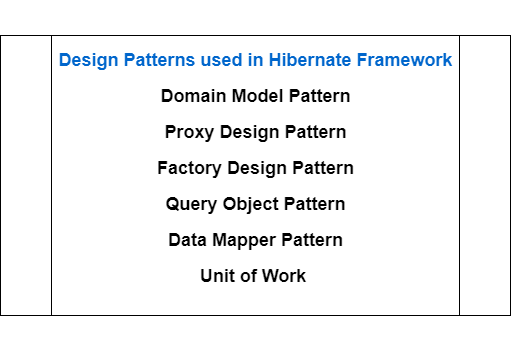Iterator Design Pattern
Intent
It is belongs to behavioral design patterns catalog.
Provide a way to access the elements of an aggregate object sequentially without exposing its underlying representation.
Provide a way to access the elements of an aggregate object sequentially without exposing its underlying representation.
Also known as
CursorAdvantage of Iterator Pattern
- It supports variations in the traversal of a collection.
- It simplifies the interface to the collection.
Structure
Participants
1. Iterator- defines an interface for accessing and traversing elements.
2. ConcreteIterator- implements the Iterator interface.
- keeps track of the current position in the traversal of the aggregate.
3. Aggregate- defines an interface for creating an Iterator object.
4. ConcreteAggregate- implements the Iterator creation interface to return an instanceof the proper ConcreteIterator.
- defines an interface for accessing and traversing elements.
- implements the Iterator interface.
- keeps track of the current position in the traversal of the aggregate.
- defines an interface for creating an Iterator object.
- implements the Iterator creation interface to return an instanceof the proper ConcreteIterator.
Collaborations
- A ConcreteIterator keeps track of the current object in the aggregate and can compute the succeeding object in the traversal.
Source code
Step 1: Create a Iterator interface.
/**
*
* ItemIterator interface.
*
*/
public interface ItemIterator {
boolean hasNext();
Item next();
}Step 2: Create Item class (iterating list of items).
public class Item {
private ItemType type;
private String name;
public Item(ItemType type, String name) {
this.setType(type);
this.name = name;
}
@Override
public String toString() {
return name;
}
public ItemType getType() {
return type;
}
public final void setType(ItemType type) {
this.type = type;
}
}Step 3 : Create enum for ItemTypes
public enum ItemType {
ANY, WEAPON, RING, POTION
}Step 4: Create TreasureChest class which holds a collection of items.
import java.util.ArrayList;
import java.util.List;
/**
*
* TreasureChest, the collection class.
*
*/
public class TreasureChest {
private List<Item> items;
/**
* Constructor
*/
public TreasureChest() {
items = new ArrayList<>();
items.add(new Item(ItemType.POTION, "Potion of courage"));
items.add(new Item(ItemType.RING, "Ring of shadows"));
items.add(new Item(ItemType.POTION, "Potion of wisdom"));
items.add(new Item(ItemType.POTION, "Potion of blood"));
items.add(new Item(ItemType.WEAPON, "Sword of silver +1"));
items.add(new Item(ItemType.POTION, "Potion of rust"));
items.add(new Item(ItemType.POTION, "Potion of healing"));
items.add(new Item(ItemType.RING, "Ring of armor"));
items.add(new Item(ItemType.WEAPON, "Steel halberd"));
items.add(new Item(ItemType.WEAPON, "Dagger of poison"));
}
ItemIterator iterator(ItemType itemType) {
return new TreasureChestItemIterator(this, itemType);
}
/**
* Get all items
*/
public List<Item> getItems() {
List<Item> list = new ArrayList<>();
list.addAll(items);
return list;
}
}Step 5: Let's create an Iterator implementation class TreasureChestItemIterator.java
import java.util.List;
/**
*
* TreasureChestItemIterator
*
*/
public class TreasureChestItemIterator implements ItemIterator {
private TreasureChest chest;
private int idx;
private ItemType type;
/**
* Constructor
*/
public TreasureChestItemIterator(TreasureChest chest, ItemType type) {
this.chest = chest;
this.type = type;
this.idx = -1;
}
@Override
public boolean hasNext() {
return findNextIdx() != -1;
}
@Override
public Item next() {
idx = findNextIdx();
if (idx != -1) {
return chest.getItems().get(idx);
}
return null;
}
private int findNextIdx() {
List<Item> items = chest.getItems();
boolean found = false;
int tempIdx = idx;
while (!found) {
tempIdx++;
if (tempIdx >= items.size()) {
tempIdx = -1;
break;
}
if (type.equals(ItemType.ANY) || items.get(tempIdx).getType().equals(type)) {
break;
}
}
return tempIdx;
}
}Step 6: Create App class to test Iterator design pattern.
public class App {
/**
* Program entry point
*
* @param args command line args
*/
public static void main(String[] args) {
TreasureChest chest = new TreasureChest();
ItemIterator ringIterator = chest.iterator(ItemType.RING);
while (ringIterator.hasNext()) {
System.out.println(ringIterator.next());
}
System.out.println("----------");
ItemIterator potionIterator = chest.iterator(ItemType.POTION);
while (potionIterator.hasNext()) {
System.out.println(potionIterator.next());
}
System.out.println("----------");
ItemIterator weaponIterator = chest.iterator(ItemType.WEAPON);
while (weaponIterator.hasNext()) {
System.out.println(weaponIterator.next());
}
System.out.println("----------");
ItemIterator it = chest.iterator(ItemType.ANY);
while (it.hasNext()) {
System.out.println(it.next());
}
}
}Applicability
Use the Iterator pattern
- to access an aggregate object's contents without exposing its internal representation
- to support multiple traversals of aggregate objects
- to provide a uniform interface for traversing different aggregate structures




Comments
Post a Comment